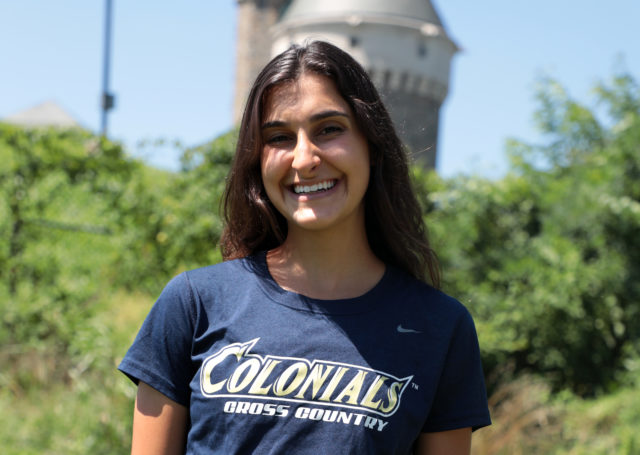
Miranda DiBiasio fell in love with running while she was in high school, relieved to find an activity that was so personally rewarding. Running allowed her to breathe, calm her nerves and find peace.
She didn’t feel as seasoned as other runners her age, and she was drawn to George Washington University, which was also growing — the Colonials were debuting track teams when she would start school. She could grow as a runner alongside a new team.
Throughout her time at GW, DiBiasio learned a lot about being a competitive runner. The track program demanded more time and energy than she had ever experienced, but she took it in stride. She quickly learned that it was no longer just about showing up for runs, it was about putting in the work off the field too — a hard lesson for a lot of runners to learn. This required more work on flexibility and a ton of work on strength to correct her form. She watched her diet like it was a religion.
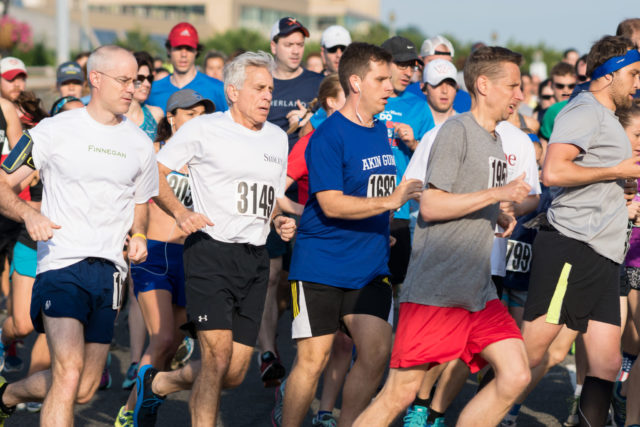
When life is dictated by 6-minute increments and responding to multiple competing demands every single day without breaking a sweat, you have a high-stress job. People who practice law are driven, competitive and have a massively high tolerance for pain and repetition. They aren’t strangers to hard work. And, when they do take time for themselves, running seems like an easy transition: just a different set of rigors. They can compete when they run – against others or their own goals. They can push their limits each and every time they throw on their shoes. But strangely, they can simultaneously use the sport to clear their heads and lose themselves in the sheer joy of pounding pavement.
And it just so happens you can’t seem to swing a pair of shoes in this region without hitting a lawyer.

Mark Cucuzzella’s highest hopes for running don’t involve him breaking the tape at a marathon. Or posting amazing sales figures at his West Virginia running store, Two Rivers Treads.
He wants every military service member to be able to run injury-free.
Recent military data showed that between 25 percent and 45 percent of soldiers suffer a musculoskeletal injury in the course of a year, despite supervision over their training. This shocked and upset Cucuzzella.
“About six years ago, the military increased the aerobic requirement, making it an indirect cause of injury,” he said. With no standard for military running footwear, soldiers can train and test in whatever shoe they please. Most often, Cucuzzella says, these 18-year-olds reach for a stability shoe because they think this will reduce their chance of injury, where he has seen just the opposite.
Cucuzzella, now a lieutenant colonel in the U.S Air Force Reserve, also serves on the faculty of the West Virginia University School of Medicine and, as far as footwear goes, is an avowed minimalist.
While running for the University of Virginia, Cucuzzella had his fair share of injuries. While he was focusing on setting his marathon PR, an impressive 2:24, his body began to show warning signs that the wear and tear of his running habits was taking its toll. He developed arthritis, his big toe joints fused and he was plagued with painful bunions. When he had surgery in 2000 to remove the bunions, he heard the words that every runner dreads — “You cannot run anymore.” In true runner form, Cucuzzella took these words with a grain of salt, and he is proud to admit, he didn’t stop running and those old college injuries were his last.
Combining his medical knowledge of anatomy and biomechanics with a penchant for research, Cucuzzella believes that what human beings have been doing for thousands of years — moving with no shoes and connecting with the ground — set the standard for safe and healthy running. He has been working hard to get all runners into the right footwear for a long time. He eschews any running shoes that bulk up the heel and is a huge proponent of zero-drop shoes. To get his message out to more people, in 2010, Cucuzzella opened Two Rivers Treads, the nation’s first minimalist shoe store, in Shepherdstown. At the shop, Cucuzzella and his staff teach movement, assess customers for foot strength and function and sell what’s right for the customer, not just what’s popular on the market.
“I’m a doc and I wouldn’t sell soda even if people wanted it,” Cucuzzella said.
With emphasis on healing runners and keeping them injury-free, Cucuzzella explains that he’s not running the store as a place of business, but rather a place of necessity.
His goal is to teach running form and injury prevention.
“Running is your means so you don’t hurt yourself,” said Cucuzzella. “Take it from the perspective of a soldier. Running isn’t their job, but they have to pass the (fitness) test. To deploy is their job. We think running causes injuries, but done right, running should make you injury resilient.”
Two Rivers Treads is Cucuzzella’s outreach to the community to advocate for good running form and injury prevention, but his passion remains taking these messages to his beloved U.S. Air Force.
Cucuzzella’s aim for the Air Force is to see that all soldiers have a shoe that will “do no harm.” He referred to an American College of Sports Medicine article published two years ago that details the best make-up of a good running shoe — no drop, light, flexible and not too soft. These are exactly the characteristics that Cucuzzella promotes in his shop, in his videos and in his own incredibly successful running career.
At the time statistics about injuries sustained during military fitness training were being released, Cucuzzella was in the Air Force Reserve, giving presentations on healthy running. He was approached by an exercise physiologist who asked him if he’d like to build something for the Air Force, given the alarming rates of injury that were being documented.
Much to his delight, Cucuzzella got a six-month sabbatical to write, film and build the modules on healthy running and injury prevention that are now on his website. The modules are broken into three components, including an overview of principles of aerobic development, a module for providers of Physical Training Leads, and finally, a module for runners to teach specific mechanics.
In the same 2010-2011 timeframe, Cucuzzella visited about 30 Air Force bases to give two-day seminars. He was able to deliver this vital information first-hand to the source he wants to have it the most.
Cucuzzella’s work has already trickled into the uniformed services’ basic training, and he couldn’t be more excited. In April of 2016, there was a policy change to the aerobic training portion of the military Physical Fitness Test. Dynamic training was adopted with functional movements and they have changed the demands of the training runs.
“Rather than running for time during training, we have turned that model upside down and have made it self-paced, just able to talk and breathe comfortably,” Cucuzzella said. “The focus is on easier running and aerobic development.”
With a combination of proper training technique and footwear, Cucuzzella believes the military can drastically reduce the number of injuries sustained by soldiers.
When he is not advocating for better military practices, he remains a competitive runner, winning the Air Force Marathon right before his 45th birthday and at 50, he is a mainstay in the top echelon of Marine Corps Marathon finishers. He’ll be running it for the 24th time Oct. 30.
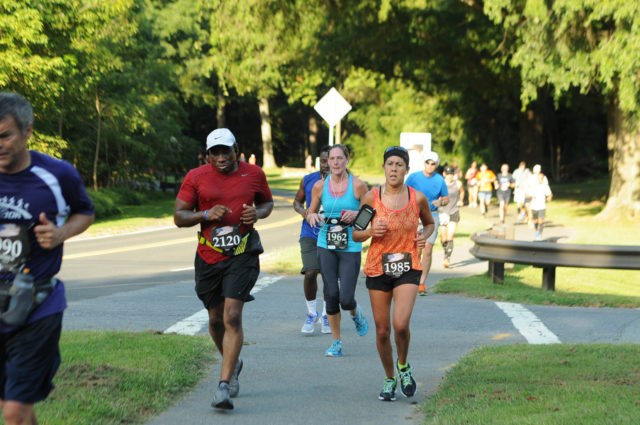
She might have had a little more sweat in her eyes this time, but Megan DiGregorio still found her way to Bethesda to win the Parks Half Marathon for the second time in three years.
The humidity made a difference this year, but didn’t keep her from putting a nearly-one-minute lead over Michelle Miller, of Damascus, 1:24:45 to 1:25:40.
It was slower than DiGregorio, of White Marsh, Md. ran in 2014 — 1:23:37 — but that didn’t bother her.
“Based on the temperature I’m happy for my time — it was tough,” she said. “Every year I look forward to seeing the tunnel with the lights, and this year was no exception.”
She said she felt chills as early as mile seven, which she attributed to dehydration exacerbated by the humidity. Though the race was shorter and flatter than the likewise-miserable Hatfield-McCoy Marathon on the mountainous Kentucky-West Virginia border, which she won in June, she said she was straining a lot more in what was a racing effort at Parks.
Even though some racers may have felt the effects of the heat, many complemented the race for being well prepared for the conditions.
“There was great communication leading up to the race,” said Laurie Themistos of D.C. “We were given advance notice of the heat and instructed how to prepare accordingly. There was also plenty of water and Gatorade on the course.”
Girma Bedada of D.C. led the pack for the men, finishing at 1:11:29, followed soon after by Brian Flynn of Bridgewater, Va. at 1:11:35. Flynn finished third last year in what was essentially a tie with second place. Coming in third was Andrew Brodeur from Bethesda in 1:12:35.
“I felt much stronger this year,” Bedada said moments after zipping through the finish. “It’s always good when you win and I’m looking forward to racing again next year.”
Flynn explained his contentment for his finish time considering the heat and humidity.
“I let the leader get away a little to much. I caught up with him and almost brought him back at nine or 10 [miles] when we hit the uphill — that was good for my positioning.”
The ease with which Flynn climbed the uphill portion didn’t exist for everyone, unfortunately.
David Lank from Baltimore enjoyed the course until he met said hill at the end, climbing into Elm Street Park in Bethesda.
“Loved the course, even with that uphill at the end, but didn’t love the weather,” Lank said.
Another finisher complemented the beautiful scenery and setting of the race.
“I love Rock Creek, its beautiful and I love it for its non-paved trails! I also love the race swag,” said Monika Schneider from Silver Spring.
This year’s race included the addition of slew of children wearing Mickey Mouse hands, ready to give high fives all morning long at the top of a particularly-tough hill.
With D.C. humidity being par-for-the course, the Parks Half Marathon chalked up as a successful event with many happy finishers.
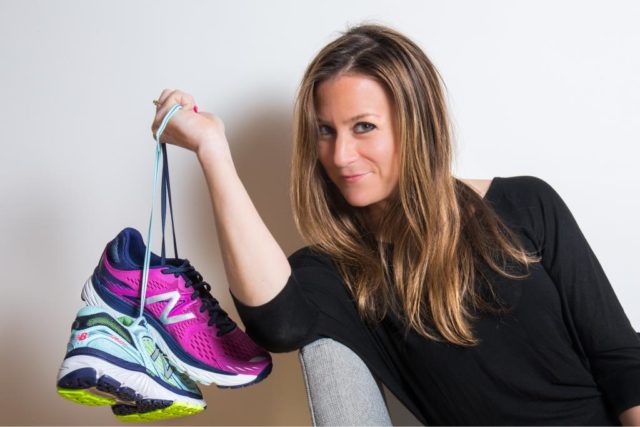
She’s Got the World on a Shoestring
The stories of women’s closets bursting at the seams with pair after pair of shoes of every style and color are legendary. Sex and the City’s Carrie Bradshaw made the lust for Manolo Blahniks or Jimmy Choos standard household fare. Sexy, stylish and always a fashion statement, shoes are not just a wardrobe staple. They are an expression of who the wearer is and where the wearer is going.
To Claire Wood, a native Virginian, shoes are as important in her life as they ever were to Carrie. It’s just a different kind of shoe – and a different life. From high school on, running shoes, not heels or espadrilles or sandals, have been a defining factor in Woods’ existence. Earlier in life, she wore them and then sold them, and now, she makes them. Wood is the senior footwear product manager in Performance Running at New Balance in Boston and is as happy as Imelda Marcos checking out the 3000 pairs of shoes in her closet.
A serious field hockey player at Oakton High School, a young Wood had visions of becoming a collegiate field hockey player. Running was nothing more than an afterthought. She ran indoor and outdoor track to train, and she worked at Footsteps of Reston part-time to make money. Running and shoes were simply side interests that she never thought in her wildest dreams would amount to anything.
Things began to change during her senior year in high school. Terry Weir, her coach her senior year of high school and now coach at George Washington University, strongly encouraged her to pursue a running career in college, instead of her intended goal of playing field hockey. Confused and unsure if she was ready to change her mind, she agreed to visit some colleges with strong running programs. She got the bug. Wood ended up walking on for cross country and track at James Madison University, and her fate was sealed. She was a runner.
“I ended up a full-blown runner, running 80 miles a week,” Wood said.
As her collegiate running career in college blossomed, Wood’s transformation to a running shoe aficionado unfolded. The transformation was an organic one. Wood’s job at Footsteps kept her working over breaks and during the summers. Owner of the local running shop, Paul Zink, was also an assistant coach at the time helping out surrounding schools, including Oakton. Zink was impressed by Wood’s great attitude and curious nature about running and shoes.
“I would teach her about the shoes and she picked up things quickly, like how the shoes worked mechanically,” Zink said. “I would let her sit on shoe presentations when reps came in each year and she would ask a lot of questions.”
Her experience from the running store began to seep into her track and field life and her track and field life seeped into how she looked at the shoes she sold. From all her time working in running stores, and running on tracks, roads and grass, she became more and more curious about running shoes and how they served the people that wore them. Wood wanted to know why shoes were made the way they were made. Her coach at JMU, Dave Rinker, capitalized on Wood’s unique set of talents and he began having her watch other teammates run and give them tips for shoes that would be best suited to the individual’s needs.
“It was sort of this cheeky thing,” Wood described, “but I loved it, I was obsessed with shoes.”
As her collegiate career as a runner came to a close, Wood began pondering if running at American University with her NCAA red shirt eligibility would be her next step, but in the end, she chose to defer. Still working in the running store, Footsteps of Reston, as her collegiate running career came to an end, Wood found herself with numerous connections and friends both in the world of runners and in the running industry. The path she chose to follow her heart into a career in running shoes was as natural to her as stilettos to a runway model.
Wood’s first gig in the running industry was as a technical representative with Mizuno. While learning this facet of the runner’s shoe world, Wood realized that she eventually wanted to work in product design. She is the person who closes her eyes and envisions what a good, stylish running shoe will look like and how it will work.
She eventually got a job with Brooks Running and started selling product in Seattle, Washington as a marketing representative. Finally, in 2009, she moved to New Balance, where she’s been now for the last seven years.
“I work with designers and engineers to create our global performance running shoes. If I’m the visionary, they’re the creators. Products that I was selling in high school hadn’t changed much, then this running boom hit and that is still continuing to happen. People are so curious and want information, and they expect information. It’s created a resurgence of freshness which everyone is enjoying.”
As the senior footwear product manager in performance running, she remains very close to the sport. She works with professional athletes who give honest feedback on the shoes and how they feel and perform. And that’s exactly where Wood found her passion, connecting New Balance to performance running.
“What I love the most is the fusion of real performance with art.”
All we runners see when we look at a new shoe on the shelf is its function and, if we’re lucky, it’s beauty. If it’s by New Balance, it’s very likely a shoe that Wood had her hands on. What we don’t see is the hard work and creativity of the process.
“It’s always difficult. Runners are vocal and sensitive people,” says Wood, “If you change something [in a shoe], you better change it for a reason.”
Wood believes that while runners want a shoe that looks good on their feet, they’re more interested in how it supports their running. “We’re creating a product that’s rooted in performance. If created a little wrong, you could risk injuring them. It’s a lot of pressure to make sure you really know you are updating for the right reasons. You don’t change something to change something; you change it to make it better.”
Wood is not done with running or shoes by a long shot. Now she runs to clear her mind and for fitness, wearing shoes she had a hand in creating while she goes. There is no doubt the pounding of feet against pavement is inspiring her next creation.
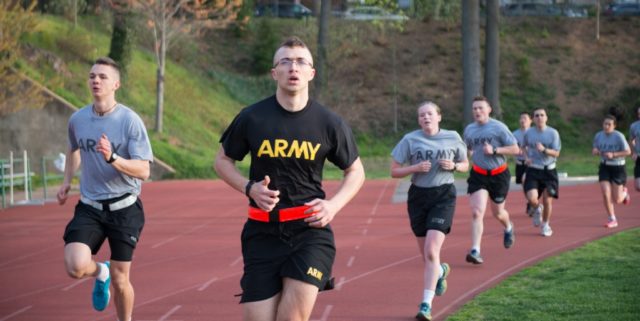
A runner’s time goals, for the most part, are arbitrary — the blend of ambition and realism. Not so for members of the Army Reserve Officers’ Training Corps, whose two-mile times count a little more than to the recreational or even competitive runner.
Early morning ROTC fitness tests are woven into the fabric of college life; for most students a myth, spread by someone who might well have been hallucinating at the tail end of an all-nighter. D.C’s Hoya Battalion comprises cadets from American University, Georgetown University, Catholic University, George Washington University and the Institute for World Politics, making it one of the largest ROTC programs in the United States.
When cadets gather for their testing at the Duke Ellington Track on the Georgetown campus, their scholarships and second lieutenant commissions are on the line. The tests consist of two minutes each of pushups and sit-ups, leading to a flat-out two-mile run. It’s about 19 minutes, max, of exertion.
“When I was a freshman, my run time was around 15 minutes for the two mile, and now hopefully, today I’ll hit 14,” said Abigail Velie, a senior from George Washington University.
Cadets consider the run the most demanding part of the test, challenging aerobic fitness and leg muscle endurance.
To prepare cadets for the running portion of the exam, the cadets meet weekly for group training runs.
“There’s no real rocket science on how we prepare for running,” said Patrick Donahue, a professor of military science at Georgetown. “Each hour-long training in the morning is broken up into warm up, pre-stretches, workout and cool down.”
The cadets must complete the Army Physical Fitness Test (APFT) twice a year and accumulate 180 points before graduation to successfully complete the rigorous physical requirements of the program.
Testing is done several times a year — mostly for practice and twice for their records. Officers join the cadets for testing, and everyone must meet the standards that include a cumulative scorecard where results from the test are continually recorded and monitored for progression, and which charts the requirements for each exercise based on the soldier’s age and sex.
Just as important as the raw results are the cadets’ progress over time, tracked on a scorecard that follows them through their service. Scoring for each of the three segments starts at zero and tops out at 100 as a perfect score in all three areas — and they have to average 60.
In late March, 140 cadets gathered at the Ellington track for their test, chilled by a morning that promised rain but held off, to their relief. Though they knew the requirements, they stood while they were repeated out loud, then watched a demonstration of how to correctly complete each part of the test. Nerves and anxiety were floating on many of their faces. For some, these results meant keeping their scholarships.
The two-mile run ahead of them meant ten laps around the track plus an additional 100 meters, a tease for anyone expecting a standard track that measures four laps to a mile. The two-mile run, as well as the other events, are a 100 percent, individual challenge. While cadets are welcome to verbally encourage their classmates, helping someone by physically touching them results in immediate disqualification.
The large group of cadets that covered the track each came to the Hoya Battalion with their own sets of strengths and weaknesses with regards to their physical fitness. Some came into the program with an athletic background, having participated in track or other sports programs in high school. Others came to the program with other strengths but openly expressed their disdain for running and the obstacles they knew they would have to overcome. All were committed to succeeding. Regardless of their previous experiences, the cadets showed their determination to improve and continue to reach higher marks for the test that was being conducted that morning.
Even freshmen who are newer to the program are excited by the physical challenges.
“This is forcing me to do more and keep up with [physical fitness], and I feel stronger overall than I would normally,” said Chloe Christensen, a freshman from George Washington University.
Christensen also expressed her excitement to be part of the Ranger Challenge training team. Membership on ROTC’s Ranger Challenge team is a special honor, reserved for the most physically fit. Participants are selected by the leaders of the ROTC program and become part of a team that will compete in Ranger Challenge, a competition where nine-person teams from each participating school go up against teams from others schools in a series of military skills events.
While the Ranger Challenge is an honor many ROTC cadets covet, not everyone came into the program with a track background and a love of running like Christensen. Nevertheless, the ROTC program makes converts to running out of most cadets.
“I was a golfer. I hated running and I love running now,” said Charles Derrik, a junior from George Washington University. “I would credit the program and being in Washington for changing that. When I came, I joined the program as a sophomore and hated running but you don’t have much of a choice.”
Derrik described his experience as being “a complete 180.” He began the ROTC program and started running through D.C. with his fellow cadets. Since then, he’s run the Marine Corps Marathon and a trail marathon, and will be trying out for the National Guard Marathon team at the end of the month.
He also credits being located in our nation’s capital as a real contributing factor in his conversion to his passion for running. The variety of historic venues and sites available for runs that can distract him on his runs is a big plus.
“Being in D.C. facilitates different workout environments,” he said. “We’ll go to ‘The Exorcist’ stairs and run around the Mall. Being able to go to different places like that kind of helps keep everyone engaged and provides a whole set of workouts.”
MSG Walker, senior military instructor at Georgetown, shared those sentiments. He credited the history and surroundings of the moments as inspiration to fuel and inspire the cadets to know, feel and see the purpose of their training — it’s all around them.
Whatever the motivation and the training regimen each cadet had used to prepare for it, they were all ready on that chilly morning when they showed up for testing.
The situps and pushups were done in the dark. Then, as the sun rose, the cadets stood in orderly military lines on the track. They were split into two separate groups on different sides of the track, and officers started the clocks. As the cadets left the starting line, the anxiety left their faces, replaced by pure focus and raw determination. As they finished, they caught their breaths, looked up, spotted someone to cheer on and began pacing and encouraging fellow cadets who had not yet finished. Although the tests are individual, no one was left behind, no one finished alone.
The high ideals and values of teamwork and no soldier left behind that the Army imparts to each cadet were on the track that morning during the APFT. The camaraderie among the cadets was moving. Walker, there to hold the cadets accountable and to push them to their physical limits, beamed as he spoke of how much he cares for and genuinely likes each member of the Hoya Battalion. They are the future leaders of the U.S. military machine, and their mettle begins being on the athletic field.
ROTC cadets are not given the choice to find a love for running or not as most runners are. Some may have this crazy passion when they show up for college and find embracing the military standards easier than others. Nevertheless, the cadets’ objective to serve their country and to be ready for any challenge at any time drives each one of them to that point on the road where a two-mile run is a measure of commitment and success.
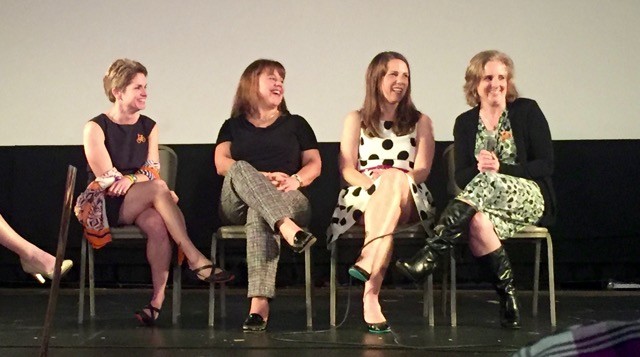
With no idea where to turn after hearing a life-changing diagnosis, local runner Heather Jeff decided to take control and make multiple sclerosis work on her terms. And after 15 years managing the condition alongside thousands of miles, the Falls Church resident shared her experience in a documentary — filmed with the help of Arlington high school students — “Living, With MS.”
Jeff is a bright-eyed, bubbly, spirited woman whose openness about MS has made the project possible. For her, running has been an incredible help to her in carrying what might otherwise be a heavy load of symptoms and challenges. Through her upbeat perspective, this possibly-dark story of disease has been turned to a hopeful, honest and even therapeutic story.
“I just wasn’t sure what to do with myself. I couldn’t really trust my body,” Jeff said about the diagnosis. “I remember saying to my doctor, should I start doing yoga? Is that the answer? Will that help this? And she was like, sure, you can do yoga, yoga is great for everybody but keep doing what you do.”
In short, there was no magic in learning to live with MS and her doctor was as interested in helping Jeff to not allow her life to be defined an autoimmune disorder that affects the central nervous system, but whatever Jeff was comfortable doing from a health and fitness perspective would be helpful. No one knew at that time just how helpful this advice would be.
Her neurologist, Heidi Crayton, diagnosed MS after Jeff had several episodes of blindness in each of her eyes. Tests revealed areas of demyelination on her brain, a classic MS symptom.
Jeff had begun running recreationally in college to combat the “freshman fifteen,” but she loved the way it made her feel and she quickly started to realize that weight control was only one of the small perks that running had to offer. She loved the way she felt when she ran and by the time of her diagnosis years later, running was simply part of her routine.
“I feel like this [advice] allowed me to be like, what can go wrong? It’s already gone wrong so I may as well just keep running,” she said.
So after talking with Crayton, Jeff dove in deeper, and started running harder and longer with renewed focus.
“I started running a lot more seriously and a lot further and with a lot more purpose,” she said. “At first, it was determination then when I got over that; it was joy.”
Jeff quickly went from 5k to the marathon, though she admits she did that a little too quickly. She has finished six marathons and continually reaps the benefits that running has to offer not just generally, but in managing the symptoms of her MS.
Going in for a routine checkup about a year ago, Jeff felt great. Crayton was delighted that Jeff remained so healthy and even commented on her success.
“I remember her looking at me and saying, ‘I don’t understand how you do this; how you’re the same every year. Nothing changes,’” Jeff said.
They shared that encouragement and they both could put their fingers on its cause — Jeff’s running. Crayton told her that treating patients with MS often has tough moments in helping newly diagnosed patients face their futures.
“She said the toughest part of her job is not so much telling someone they have MS because by the time patients reach her (the diagnosis is) obviously on the table, but it’s having something positive to share, like a message of hope to show that once you hear those words, it’s not the end,” Jeff said. “And that just resonated with me.”
That conversation sparked her imagination. If running meant a stable life, free of fear of her condition, it represented a future that MS patients could look to in the dark confusion that comes after hearing a diagnosis.
“People don’t share the happy stuff, people don’t share the stories,” Jeff said. “I don’t think that’s been picked up by the MS world; the uplifting part. So I thought about it, ran, thought about it and talked about it with my running friends and spent a lot of time thinking, how can I make a difference? That to me felt like a call to action. That to me was very clear. There needs to be something out there that’s different.”
At the time, Jeff had had a blog for about a year (http://findyourinnerpace.com) and thought first of using this channel to spread her message of running to help manage the symptoms and stress of living with MS. But after a bit of advice from a friend, she shifted gears toward creating a video to reach even more people.
So after much research, and with a lot of help from friends, old and new, the documentary, “Living, with MS,” began to take form. Instantly, she was connected through word-of-mouth in the running community to other athletes with MS and people who could help her produce the film, students from H.B Woodlawn High School. Her original vision slowly took shape until it finally became a touching and inspirational 23-minute film that debuted this past weekend at the Arlington Draft House.
The documentary features Jeff, Theresa Urban, Kate Morse, Crayton, and former Georgetown basketball player Chris Wright. Each person relates small parts of their journeys with MS while Crayton explains her medical perspective on the condition, emphasizing that she wants her patients to think of the diagnosis as second, not first, when asked what they should change or do differently. In a word, Crayton says, “nothing.”
The women, Urban, Morse and Jeff, showcase how running and athletics has helped each of them combat their diagnoses, both physically and mentally. Images of the women cycling and running through Haynes Point, as well as doing squats and overhead presses with dumbbells panned across the screen inspiring the more than 300 people who showed up for the documentary’s premiere.
Their message of hope rippled through the audience as they answered questions from the audience after the film was shown. There was a palpable thread of camaraderie that connected them all. Their synonymous take away message? Find your tribe, regardless of a diagnosis of MS or a completely healthy body. Lean on your training teams, your family, your friends, and find the people that can support you through your journey and live each day to the fullest.

